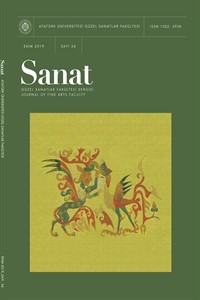Öz
The aim of this study is to develop a valid, reliable
and useful measurement tool that can measure improvisation skills. The research
is a descriptive study conducted with general screening method. First of all,
in the study, the literature was searched and the measurement tools for musical
improvisation and musical instrument performance were analyzed and the items
for the measurement tool have been formed. Items and coefficient ratios of the
draft scale were presented to ten experts. A 5-point likert-type 15-item scale
has been developed by making necessary corrections in line with the
recommendations. The final version of the scale, which was presented to the
expert opinion again, has been formed and piloted to test the
validity-reliability situations. Factor analysis was applied to ensure the
construct validity of the scale. Kaiser-Meyer-Olkin and Bartlett tests were
performed to test the suitability of the scale for factor analysis. Cronbach’s
Alpha internal consistency coefficients were analyzed and item-total
correlations were examined for reliability of the instrument. Afterwards, Kendall-W
Test was applied to check the harmony between raters. In the application part
of the study, musical improvisations produced by 16 professional and amateur
music performers were evaluated by 7 experts. The expressions in each item were
evaluated as 5-point likert type, with the lowest grade being “1” and the best
grade being “5”. According to the
results of factor analysis and item analysis, it has been found that the scale
is a single factor and is not a significant item reducing reliability. According
to the results of Kendall-W test and Pearson product-moment correlation between
raters, there has been an extremely high correlation between raters. The
reliability coefficient (Cronbach’s alpha) of the scale has been determined as
0.981. In this respect, it is concluded that the scale has internal consistency
and is highly reliable.
Anahtar Kelimeler
Kaynakça
- Abeles, H. F. (1973). Development and validation of a clarinet perfor- mance adjudication scale. Journal of Research in Music Education, 21, 246-255
- Aydın, B. (2018). Ortaokul Ve Lise Düzeyinde Öğrenim Gören Konservatuvar Öğrencilerinin Müzik Performans Kaygılarının Çeşitli Değişkenlere Göre İncelenmesi. (Yayımlanmış Doktora Tezi), Dokuz Eylül Üniversitesi Eğitim Bilimleri Enstitüsü, İzmir,
- Bevan, N., & Macleod, M. (1994). Usability measurement in context. Behaviour & information technology, 13(1-2), 132-145.
- Koutsoupidou, T. (2005). Improvisation in the English primary music classroom: Teachers’ perceptions and practices. Music Education Research, 7(3), 363-381.
- Macleod, M., & Rengger, R. (1993). The development of DRUM: A software tool for video-assisted usability evaluation. People and Computers, 293-309.
- Miner, B. (2007). Fostering musical creativity in the elementary classroom. Inquiry Journal.
- Smilde, R. (2013, November). Improvisation and identity: a biographical perspective. In ERASMUS European Impro Intensive 2013 Seminar:“Improvisation and Today’s Concert Practice” (pp. 17-24).
- Uslu, Mustafa (1998.), Türkiye'de çalgı eğitiminin yaygınlaştırılması ve geliştirilmesi, (Yayımlanmamış Doktora Tezi), Marmara Üniversitesi Fen Bilimleri Enstitüsü, İstanbul,
- Zdzinski, S. F. (1991). Measurement of solo instrumental music performance: A review of literature. Bulletin of the Council for Research in Music Education, 47-58.
Öz
Bu araştırmanın amacı, doğaçlama
çalabilme becerilerini ölçebilecek geçerli, güvenilir ve kullanışlı bir ölçme
aracı geliştirmektir. Araştırma, genel tarama yöntemiyle yürütülen betimsel bir
çalışmadır. Araştırmada öncelikle, literatür taraması yapılarak müzikal doğaçlama
ve müzik çalgı performansına yönelik ölçme araçları incelenmiş ve ölçme aracına
yönelik maddeler oluşturulmuştur. Taslak ölçeğin maddeler ve katsayı oranları
10 alan uzmanına sunulmuştur. Öneriler doğrultusunda gerekli düzeltmeler yapılarak
5’li likert tipinde 15 maddelik bir ölçek oluşturulmuştur. Tekrar uzman
görüşüne sunulan ölçeğin son hali oluşturulmuş ve geçerlik-güvenirlik
durumlarının sınanması için pilot uygulaması yapılmıştır. Ölçeğin yapı
geçerliğinin sağlanması için faktör analizi yapılmıştır. Ölçeğin faktör
analizine uygun olup olmadığının test edilmesi için Kaiser-Meyer-Olkin ve
Bartlett testi yapılmıştır. Ölçme aracının güvenirliği için Cronbach’s Alpha iç
tutarlık katsayılarına bakılmış ve madde-toplam korelasyonları incelenmiştir.
Daha sonra puanlayıcılar arasındaki uyuma bakmak için Kendall-W Testi
uygulanmıştır. Araştırmanın uygulama aşamasında, profesyonel ve amatör 16 müzik
icracısı tarafından üretilen müzikal doğaçlamalar hazırlanan ölçek ile 7 uzman
tarafından değerlendirilmiştir. Her bir maddede yer alan ifadeler en düşük not
“1” en iyi not “5” olmak koşuluyla 5’li likert tipinde değerlendirilmiştir. Yapılan
faktör analizi ve madde analizi sonuçlarına göre, ölçeğin tek faktörlü olduğu
ve güvenirliği önemli derecede azaltan bir madde olmadığı tespit edilmiştir. Puanlayıcılar
arası uyuma için yapılan Kendall-W testi ve Pearson momentler çarpımı
korelasyonu sonuçlarına göre puanlayıcılar arasında son derece yüksek bir uyum olduğu
görülmüştür. Ölçeğin güvenirlik katsayısı (cronbach alfa) 0.981 olarak tespit
edilmiştir. Bu doğrultuda ölçeğin iç tutarlığa sahip olduğu ve yüksek derecede
güvenilir olduğu sonucuna ulaşılmıştır.
Anahtar Kelimeler
Kaynakça
- Abeles, H. F. (1973). Development and validation of a clarinet perfor- mance adjudication scale. Journal of Research in Music Education, 21, 246-255
- Aydın, B. (2018). Ortaokul Ve Lise Düzeyinde Öğrenim Gören Konservatuvar Öğrencilerinin Müzik Performans Kaygılarının Çeşitli Değişkenlere Göre İncelenmesi. (Yayımlanmış Doktora Tezi), Dokuz Eylül Üniversitesi Eğitim Bilimleri Enstitüsü, İzmir,
- Bevan, N., & Macleod, M. (1994). Usability measurement in context. Behaviour & information technology, 13(1-2), 132-145.
- Koutsoupidou, T. (2005). Improvisation in the English primary music classroom: Teachers’ perceptions and practices. Music Education Research, 7(3), 363-381.
- Macleod, M., & Rengger, R. (1993). The development of DRUM: A software tool for video-assisted usability evaluation. People and Computers, 293-309.
- Miner, B. (2007). Fostering musical creativity in the elementary classroom. Inquiry Journal.
- Smilde, R. (2013, November). Improvisation and identity: a biographical perspective. In ERASMUS European Impro Intensive 2013 Seminar:“Improvisation and Today’s Concert Practice” (pp. 17-24).
- Uslu, Mustafa (1998.), Türkiye'de çalgı eğitiminin yaygınlaştırılması ve geliştirilmesi, (Yayımlanmamış Doktora Tezi), Marmara Üniversitesi Fen Bilimleri Enstitüsü, İstanbul,
- Zdzinski, S. F. (1991). Measurement of solo instrumental music performance: A review of literature. Bulletin of the Council for Research in Music Education, 47-58.
Ayrıntılar
| Birincil Dil | Türkçe |
|---|---|
| Bölüm | Makaleler |
| Yazarlar | |
| Yayımlanma Tarihi | 17 Ekim 2019 |
| Gönderilme Tarihi | 20 Eylül 2019 |
| Yayımlandığı Sayı | Yıl 2019 Sayı: 34 |

Bu eser Creative Commons Atıf-GayriTicari 4.0 Uluslararası Lisansı ile lisanslanmıştır.


